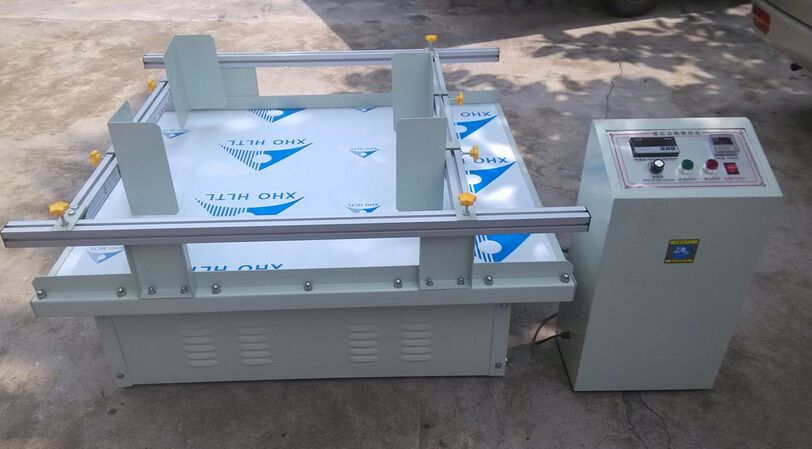ASTM D999 Vibration Testing of Packages
The ASTM D999 standard specifies a procedure to determine the resistance of packages to vibration. This testing method is crucial for ensuring that packaging materials and designs can withstand the rigors of transportation, thereby protecting the integrity of the products they contain. In this section, we will delve into the specifics of what ASTM D999 entails, including its application in various sectors such as pharmaceuticals, electronics, and consumer goods.
The procedure outlined in ASTM D999 involves placing a specimen package containing the product under test (POT) on a vibrating table that simulates real-world transport conditions. The vibrations are typically sinusoidal or random and are applied over a range of frequencies and amplitudes to evaluate how well the packaging can withstand these stresses without compromising its integrity.
The primary objective of ASTM D999 is to assess whether the package design will protect the product during transport by land, sea, or air. Compliance with this standard ensures that manufacturers meet regulatory requirements and industry expectations for product protection during shipment.
For quality managers and compliance officers responsible for ensuring packaging meets these stringent standards, conducting ASTM D999 testing is essential. R&D engineers also rely on this test to optimize package designs while maintaining or improving their protective capabilities. Procurement teams benefit from the results of such tests as they help identify reliable suppliers capable of delivering packages that meet the necessary specifications.
Understanding the nuances of ASTM D999 helps stakeholders appreciate why it matters in various industries. For instance, pharmaceutical manufacturers need robust packaging to safeguard temperature-sensitive drugs and medical devices during transit. Similarly, electronics firms require effective vibration protection for delicate components within their products. Consumer goods companies aim to protect items like cosmetics or foodstuffs from damage due to jostling during distribution.
The importance of ASTM D999 cannot be overstated; it plays a vital role in safeguarding both the quality and safety of transported goods across multiple sectors.
Why It Matters
- Ensures product protection during transportation
- Promotes compliance with industry standards
- Aids in optimizing package design for better performance
- Enhances supply chain reliability by minimizing damage risk
The significance of ASTM D999 lies not only in its ability to assess the durability of packaging materials but also in its contribution towards maintaining consistent quality standards across different industries. By adhering to this standard, companies can ensure that their products arrive at destination intact and undamaged.
For those involved in quality assurance processes or supply chain management, understanding how ASTM D999 impacts these areas is crucial. It provides valuable insights into potential risks associated with non-compliant packaging solutions while offering guidance on best practices for achieving optimal results.
Applied Standards
The primary standard used in ASTM D999 vibration testing is, of course, ASTM D999 itself. However, other relevant standards may also apply depending on the specific requirements set by different industries or regulatory bodies.
In addition to ASTM D999, ISO 16730:2015 provides guidelines for packaging that undergoes cyclic loading in a laboratory environment. This international standard offers additional perspectives on package design and performance evaluation under simulated transport conditions.
Other related standards include ASTM E438, which deals with the determination of mechanical properties of materials by means of ring-impact testing; EN 13102 for protective packaging systems; and IEC 60975, concerning electrical characteristics of protective packaging.
The use of these complementary standards ensures a comprehensive approach to package testing, addressing various aspects from material strength to environmental factors that could affect the performance of the packaging during transit.
Use Cases and Application Examples
| Industry Sector | Type of Package Tested | Test Conditions | Expected Outcomes |
|---|---|---|---|
| Pharmaceuticals | Bulk shipping containers for medications | Vibrations at 50 Hz with an amplitude of ±1.25 mm | Evaluation of container integrity and contents stability |
| Electronics | Transport cases for consumer electronics | Vibrations at 60 Hz with an amplitude of ±1.5 mm | Determination of case resilience against potential damage from shaking during air travel |
| Consumer Goods | Pallets of packaged consumer items | Vibrations at 40 Hz with an amplitude of ±1 mm | Assessment of pallet stability and product safety during ground transportation |
- Pharmaceutical companies often face strict regulations regarding drug storage temperatures. Proper packaging must maintain these conditions throughout transit.
- Electronic devices are particularly susceptible to shock when packaged incorrectly, necessitating rigorous testing protocols like those prescribed by ASTM D999.
- Consumer goods face various challenges in maintaining product freshness and preventing damage during shipment, requiring thorough evaluation of packaging effectiveness.
The diverse range of applications underscores the versatility and importance of ASTM D999 vibration testing across numerous industries. Whether it's protecting pharmaceuticals from temperature fluctuations or safeguarding delicate electronics against mechanical impacts, this standard plays a critical role in ensuring product safety and integrity during transport.





